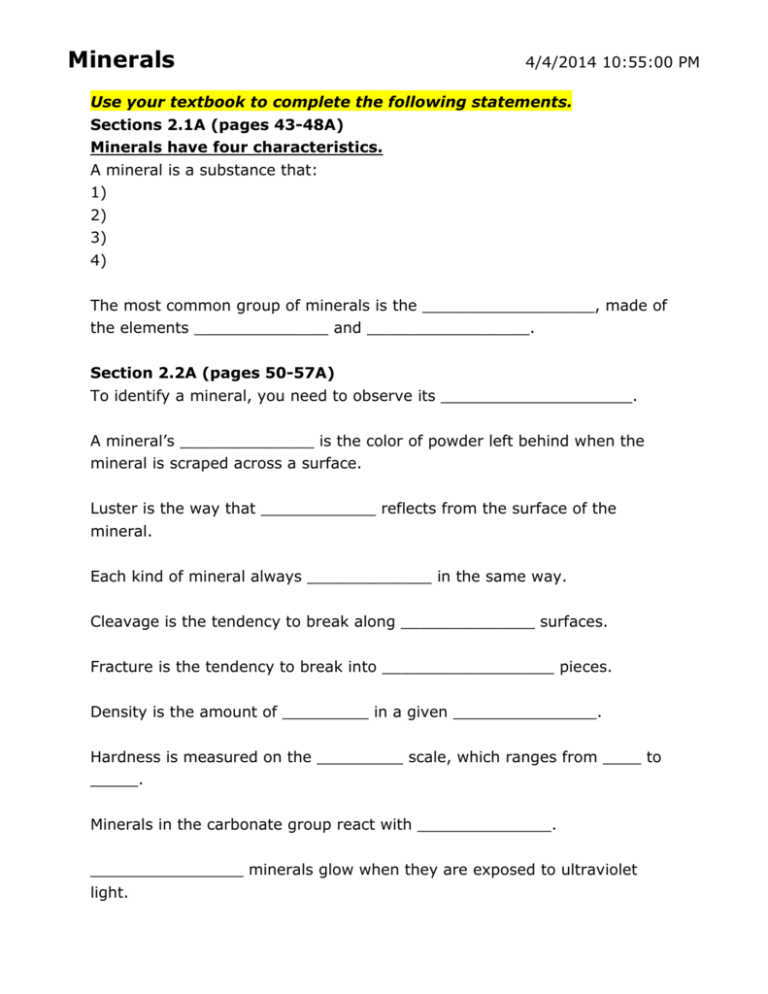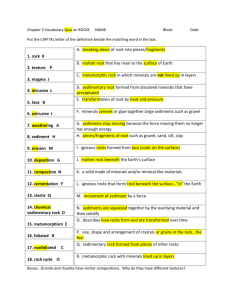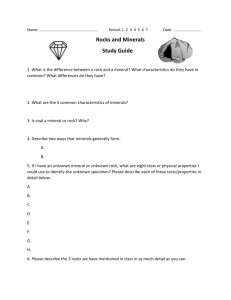Sedimentary rock
advertisement

Minerals 4/4/2014 10:55:00 PM Use your textbook to complete the following statements. Sections 2.1A (pages 43-48A) Minerals have four characteristics. A mineral is a substance that: 1) 2) 3) 4) The most common group of minerals is the __________________, made of the elements ______________ and _________________. Section 2.2A (pages 50-57A) To identify a mineral, you need to observe its ____________________. A mineral’s ______________ is the color of powder left behind when the mineral is scraped across a surface. Luster is the way that ____________ reflects from the surface of the mineral. Each kind of mineral always _____________ in the same way. Cleavage is the tendency to break along ______________ surfaces. Fracture is the tendency to break into __________________ pieces. Density is the amount of _________ in a given _______________. Hardness is measured on the _________ scale, which ranges from ____ to _____. Minerals in the carbonate group react with ______________. ________________ minerals glow when they are exposed to ultraviolet light. Igneous Rocks, pages 82-87A 4/4/2014 10:55:00 PM Be sure to answer each of the highlighted questions. Rhyolite sample Granite Sample Examine the two samples of rock, granite and rhyolite, which are made of the same minerals. Why do you think they look so different? Explain the difference between intrusive and extrusive igneous rock and how cooling time affects crystal size. Describe how the silica content of the lava affects how it flows. Sedimentary Rocks, pages 89-95A 4/4/2014 10:55:00 PM View the demonstration of how different materials (gravel, sand, and water) settle when mixed in a jar. What determines how they settle? In a lake, how would a mixture of different sized rock particles settle to the bottom? Use the textbook (pages 89-93A) to describe each of the three ways that sedimentary rocks form. Sedimentary Rocks form from: Rock particles Plants or shells Minerals dissolved in water Name three ways sedimentary rocks can give information about the past. Are these statements true? If not, correct them. 1. Sedimentary rocks form when older rocks are heated. 2. Most sedimentary rock is found at the surface of Earth’s crust. 3. Some sedimentary rocks form as loose materials get cemented together. Metamorphic Rocks, pages 96-101A 4/4/2014 10:55:00 PM View the rock samples. Shale is the original rock. Make a prediction about what conditions could transform shale into the other rock. After looking at page 96A, what are the two factors that change rocks? Use pages 100-101A to describe the main differences between foliated and non-foliated metamorphic rocks. The Rock Cycle, pages 75-80A 4/4/2014 10:55:00 PM After completing the rock cycle activity, answer the following questions: 1. Why isn’t every path through the rock cycle exactly the same? 2. Which process changes igneous rock into metamorphic rock? 3. Which processes change sedimentary rock into igneous rock? 4. Which processes change metamorphic rock into sedimentary rock? 5. Metamorphism involves the addition of _______________ and _______________ to pre-existing rocks. 6. Compaction & cementation of sediments forms _______________ rocks. 7. In order to form magma, what must happen to sedimentary, metamorphic or igneous rocks? 8. Can sedimentary rock form directly from metamorphic rock? 9. Which layer of Earth contains the most rock-forming minerals? 10. The most common type of rock at Earth’s surface is ______________. Weathering and Soil, pages 115-129A4/4/2014 10:55:00 PM Describe each type of weathering and give two examples. Weathering can be: Mechanical Chemical – Soil Profile Match each description to the correct layer (give the letter from above): Solid bedrock Red clay dirt Broken pieces of rock Sand & silt Topsoil Organic layer (humus) Answer these questions: In a soil profile, which horizon has the most organic matter and is also called topsoil? What type of matter breaks down to form humus? Which horizon in a soil profile is made mostly of clay and reddish in color? Chapter 3 Review 4/4/2014 10:55:00 PM Answer questions 12-19 on page 105A below. 12. The a. b. c. d. three groups of rocks are sedimentary, metamorphic, and limestone granite igneous coal 13. The rock cycle shows how rocks continually a. increase in size b. increase in number c. become more complex d. change over time 14. Which kind of rock forms when molten rock cools? a. metamorphic b. sedimentary c. igneous d. extrusive 15. An existing rock can change into another type of rock when it is subjected to great a. pressure b. winds c. flooding d. foliation 16. Which kind of rock forms by recrystallization? a. b. c. d. intrusive igneous extrusive igneous sedimentary metamorphic 17. Geologists classify an igneous rock on the basis of its crystal size and the amount of ________ its minerals contain. a. carbon b. silica c. sediment d. foliation 18. Pieces of rock can settle from water and get cemented into a. metamorphic rock b. sedimentary rock c. igneous rock d. extrusive rock 19. Rock salt is an example of a sedimentary rock that develops from dissolved minerals as a. water evaporates b. magma cools c. sediments break down d. sand settles in water Rocks & Soil Vocabulary 4/4/2014 10:55:00 PM Define each of the following terms. Use Chapters 2 & 3 of Unit A, the textbook glossary, or any dictionary. Mineral Streak Luster Cleavage Fracture Density Hardness Igneous rock Intrusive Extrusive Sedimentary rock Metamorphic rock Metamorphism Recrystallization Foliation - Study Guide for Test 4/4/2014 10:55:00 PM Use your textbook, pages 43-136A, as well as your mini lessons and the other pages of this file to answer the following questions. 1. What are the four characteristics of minerals? 2. Which mineral group is the most common on Earth? 3. Which layer of Earth contains the most rock-forming minerals? 4. The color of a mineral’s powder is called _____________________. 5. If two minerals of different hardness are rubbed together, what will be the result? 6. “Metallic” is a type of ________________. 7. If a mineral has cleavage, it will break _______________. 8. The processes that change rocks are part of the ___________ cycle. 9. The most common type of rock at Earth’s surface is ______________. 10. Rock that forms from magma cooling inside the Earth is called __________ igneous rock. 11. Lava that is low in silica flows ____________. 12. Limestone is an example of _______________ rock forming when dissolved minerals re-form. 13. Coal is made from the remains of ________________. 14. Name three ways sedimentary rocks can give information about the past. 15. The arrangement of minerals into parallel bands during metamorphism is called__________________________. 16. In a soil profile, which horizon has the most organic matter and is also called topsoil? 17. What type of matter breaks down to form humus? 18. Which type of weathering changes the chemical composition of rock? 19. Which horizon in a soil profile is made mostly of clay and reddish in color? Use the Mohs Scale above to answer questions 20-25. 20. Which minerals are softer than fluorite? 21. Why couldn’t you use a steel file to tell the difference between topaz and quartz? 22. Which minerals are harder than quartz but softer than diamond? 23. Why couldn’t you use a fingernail to tell the difference between calcite and feldspar? 24. If the mineral scratches fluorite but not topaz, what is its hardness? 25. Which minerals can be scratched with steel but not your fingernail?









